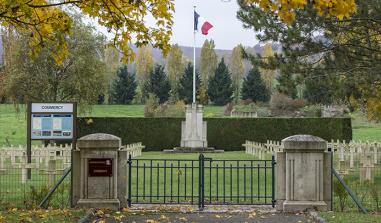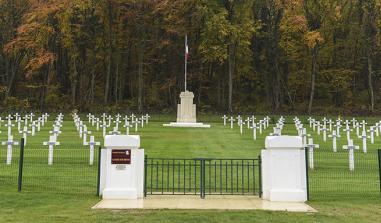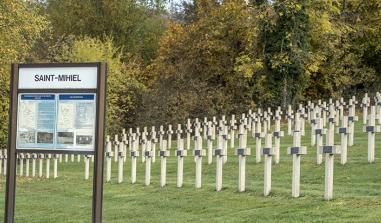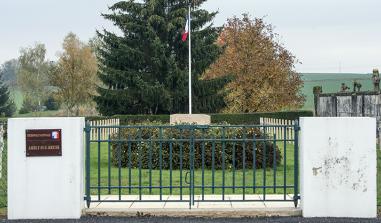Vauquois
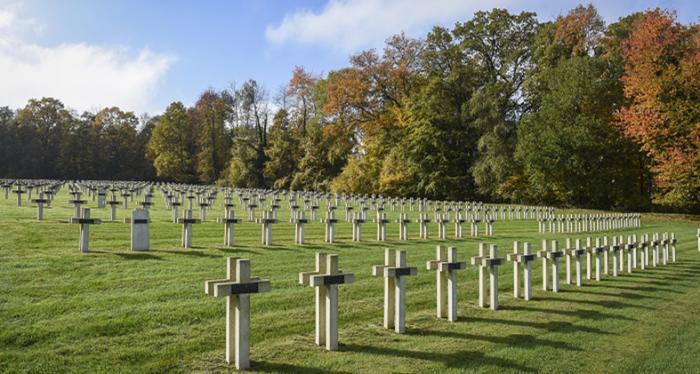
Vauquois National Cemetery. © ECPAD
Click here to view the cemetery's information panel 
Vauquois National Cemetery holds the remains of 4 368 soldiers, including 1 970 in the ossuary. These soldiers, mainly belonging to the 46th, 76th and 31st RI, died for France during the battles on the “Butte” of Vauquois. Established in 1923, the cemetery has, since 1924, been used for the burial of remains from the military cemeteries in the Vauquois-Cheppy region and Hesse Forest (Vauquois, Clerment-en-Argonne, Cheppy, La Barricade, Auzeville, Neuvilly, Boureuilles, Pont-des-Quatre-Enfants, Les Ailleux, Chemin-Creux, Bois-Noir, La Cigalerie, Petit-Poste, Le Terrier, Aubreville, Parois, Rochamp, Bois-de-Cheppy, Bon-Abri, Courcelles, Marcq, Apremont and Chatel).
Among the soldiers buried there are the remains of Henri Collignon, a Councillor of State and former general secretary of the Élysée, who at age 58 enlisted as a volunteer in the 46th RI. He was killed in action on 15 March 1915.
Fighting on the Butte de Vauquois, 1914 to 1918
Since the French Revolution, the Argonne massif had been known as the “French Thermopylae”, and in 1915 it became one of the most disputed sectors. Located between Champagne and Verdun, it constituted a barrier between these two major First World War battle zones. This densely forested massif made for tough fighting conditions, and the terrain meant that the movement of troops was particularly difficult. Static warfare took on its own particular meaning here, as French and German attacks soon deteriorated into senseless, bloody mêlées.
Set on a natural observation point, 290 metres above the Aire and Buanthe valleys, from September 1914 the village of Vauquois became one of the Argonne’s strategic positions. In autumn 1914, the Germans turned it into a veritable fortress. In February and March 1915, the village was fiercely contested. Troops of the 9th and 10th Infantry Divisions showed great heroism. Despite the failure of preparations by the artillery and engineers, on the morning of 17 February the 31st Infantry Regiment launched its attack. Galvanised by its musicians who, at the sight of the enemy, played the Marseillaise, the regiment succeeded in reaching the ruins of the church. Pounded by German artillery crossfire, the unit’s few survivors abandoned that position to take up a new one halfway down the hill. Further assaults were impossible. In these circumstances, mine warfare became the only alternative.
Rivalling one another in skill and effort, French sappers and German pioneers dug underground galleries to carry explosives as far as the mine chamber. This strategy was initially used to accompany the French infantry who, at that time, could not be supported by heavy artillery. After the roar of the mine, through the smoke and under a hail of earth, the soldiers rushed forwards to occupy the designated objective. One after another, the attacks went on. On 5 March, the French took Vauquois, with heavy losses, but the hill continued to be fiercely disputed.
After the bloody attacks of winter 1915, the engineer units set about digging deeper and deeper pits and using more and more powerful charges. Altogether, nearly 17 km of mines were dug on the German side and 5 km on the French side. Like battleships in the night, two rival work units would sometimes collide with one another in the near darkness. As André Pézard writes in Nous autres à Vauquois, throughout 1915, “Vauquois was never a quiet sector.”
The mine war continued, reaching its height in May 1916, when a mine of 60 to 80 tonnes went off, killing 108 men of the 46th RI and leaving a massive crater. After this explosion, which brought no progress to speak of, both French and Germans limited themselves to defensive combat. In March 1918, mine warfare was abandoned for good. In May-June, Italian troops relieved the French soldiers. In September, a powerful Franco-American attack permanently recaptured the hill.
The 82nd, 331st, 46th, 113th, 131st, 31st, 76th, 89th, 313th, 358th and 370th Infantry Regiments, 42nd Colonial Infantry Regiment and 138th and 139th US Infantry Regiments, not forgetting a detachment of the Paris fire brigade, were the main units to distinguish themselves in the assault.
Today, Vauquois is a unique site in First World War history and remembrance. A symbol of this bitter struggle, Vauquois represents the memory of 10 000 soldiers who were buried forever. There is nothing left of the village itself. Proof of the men’s tenacity, the summit of the hill is today 18 metres lower than it was in 1914. In the midst of this lunar landscape stands a memorial to the dead and to this village that “died for France”, where once a hundred-year-old chestnut tree proudly stood.
Vauquois National Cemetery. © Guillaume Pichard
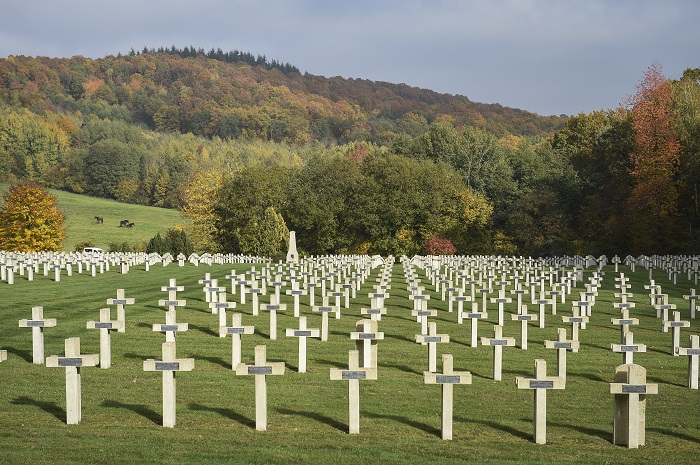
Vauquois National Cemetery. © ECPAD
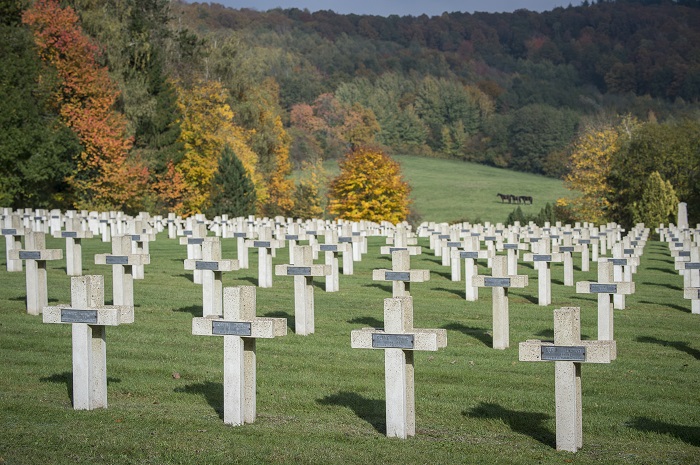
Vauquois National Cemetery. © ECPAD
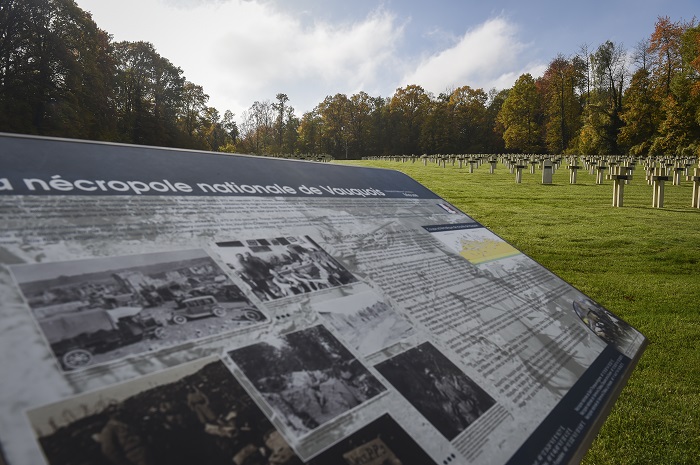
Vauquois National Cemetery. © ECPAD
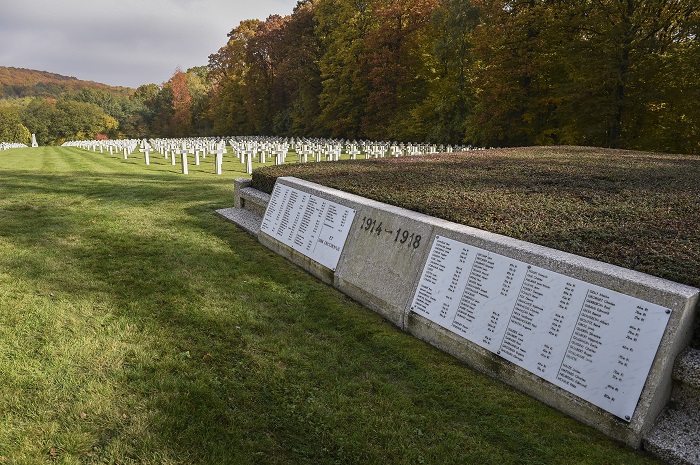
Vauquois National Cemetery. © ECPAD
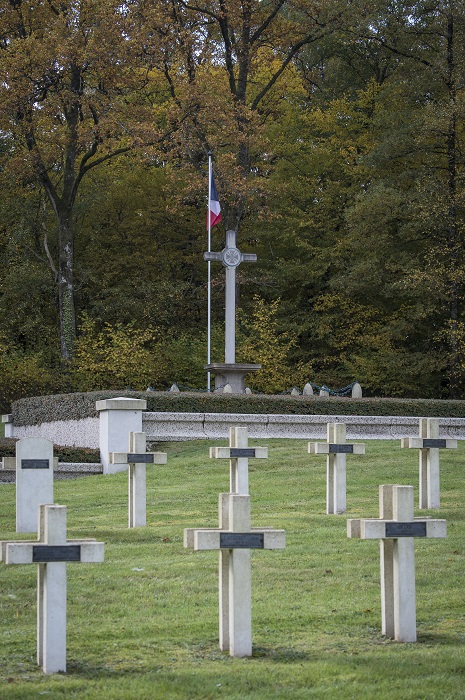
Vauquois National Cemetery. © ECPAD
Vauquois National Cemetery. © Guillaume Pichard
Vauquois. © Guillaume Pichard
Vauquois. © Guillaume Pichard
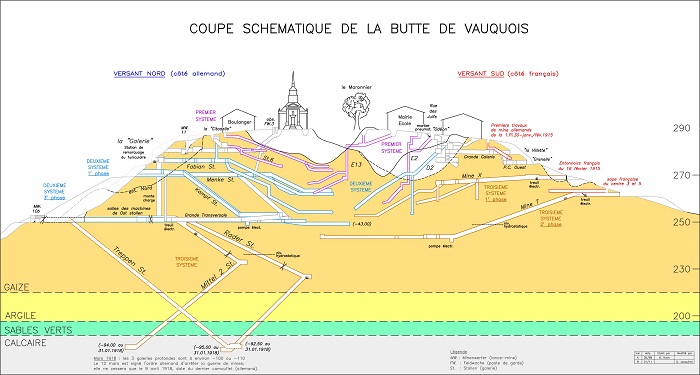
Cross-section of the Butte de Vauquois
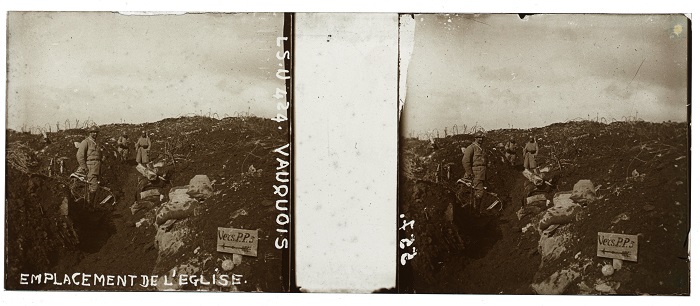
Site of the former church of Vauquois. On 6 June 1915, around the ruins of the church of Vauquois, a detachment of the Paris fire brigade provided special support to an infantry assault. Equipped with Schilt flamethrowers, the men projected inflammable liquid over the German lines, which they ignited using incendiary grenades. When the wind changed direction, the operation ended in tragedy: 20 men were burnt alive. Source: Musée de la Grande Guerre du Pays de Meaux
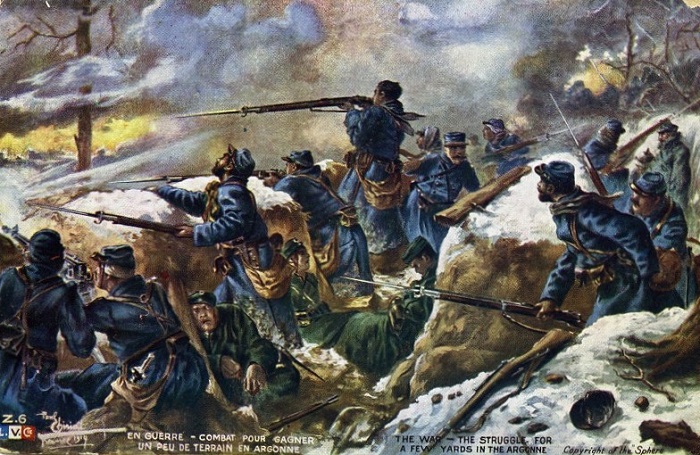
Defending a trench. This illustration from a period postcard offers an insight into how the realities of the fighting of winter 1915 were perceived on the home front. Source: Musée de la Grande Guerre du Pays de Meaux
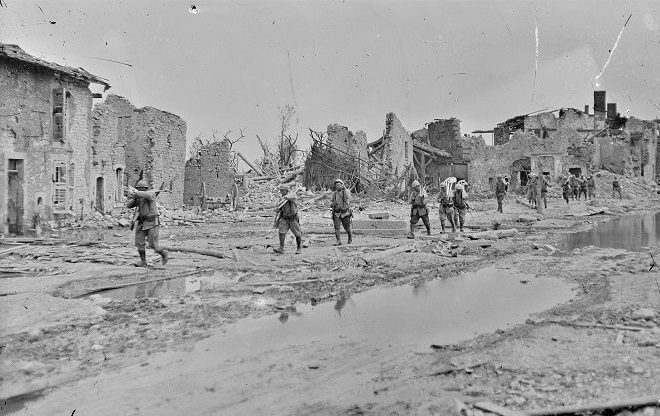
French soldiers beside ruins of the village of Esnes-en-Argonne, 25 July 1916. © ECPAD/Pierre Pansier
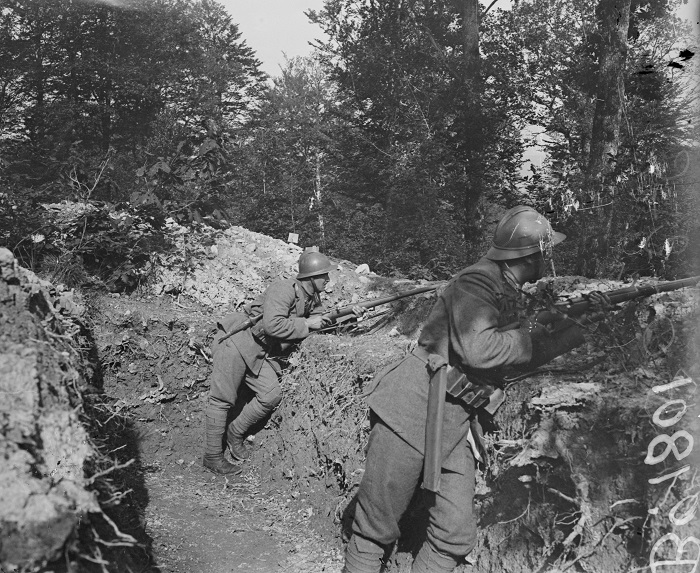
Italian infantrymen on the front line near Vauquois, May 1918. Italian troops were engaged in the Hesse Forest sector from May-June 1918 onwards. © ECPAD/Maurice Boulay
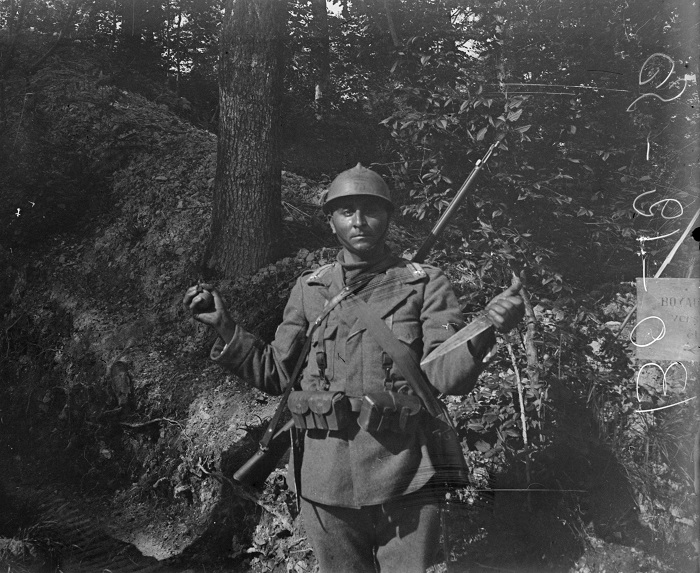
An Italian trench clearer near Vauquois, Hesse Forest, May 1918. As the troops advanced, it was important to render harmless any enemy soldiers who remained in the trenches, because it meant ensuring there was no enemy at your back. The task of trench clearance gave rise to a whole host of bloody tales and legends more or less true to reality. Specialised units carried out these operations, using handguns, grenades or, less often, knives. © ECPAD/Maurice Boulay
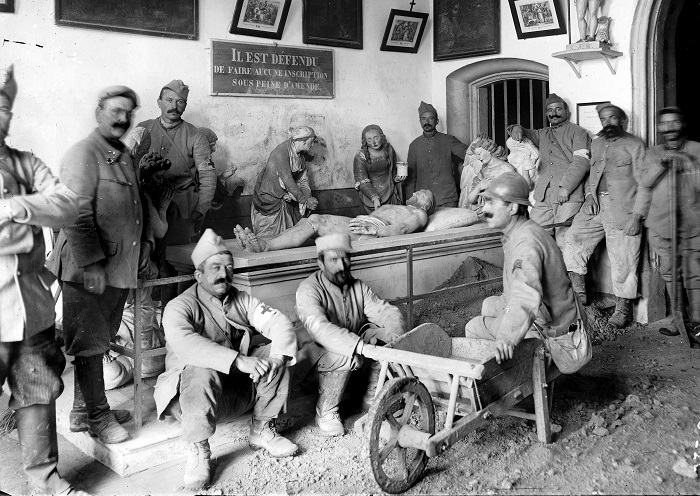
Moving a statue of Christ in the church of Clermont-en-Argonne, March 1918. The areas around the front were destroyed, and the churches, with their religious and architectural heritage, were not spared. Sometimes soldiers moved pieces of church furniture to protect them from shelling or looting. © ECPAD/Jacques Agié
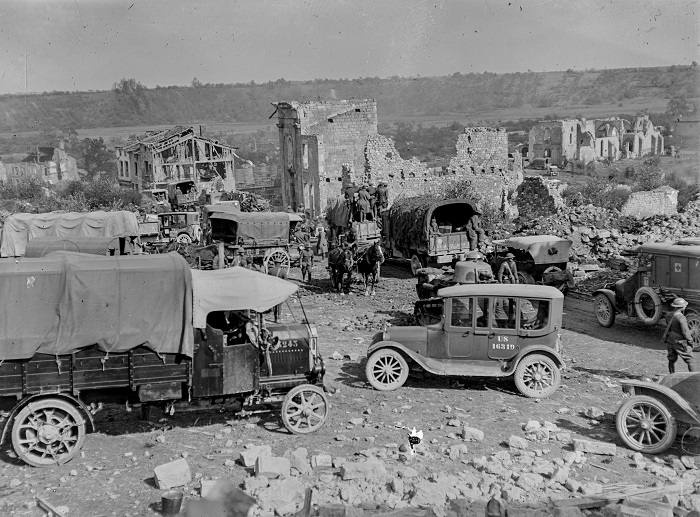
American troops at Montfaucon, September 1918. The Argonne is a major American remembrance site in Europe. Romagne-sous-Montfaucon is home to the biggest American military cemetery in Europe, with 14 246 graves in an area of 52 hectares. The names of 954 soldiers are inscribed on Tablets of the Missing. © ECPAD/Emmanuel Mas
Practical information
Vauquois
Summary
Eléments remarquables
Read more
Read more
Comité départemental du tourisme de la Meuse
33, rue des Grangettes 55012 Bar-le-Duc Cedex
+33 (0)3 29 45 78 40 - www.tourisme-meuse.com




